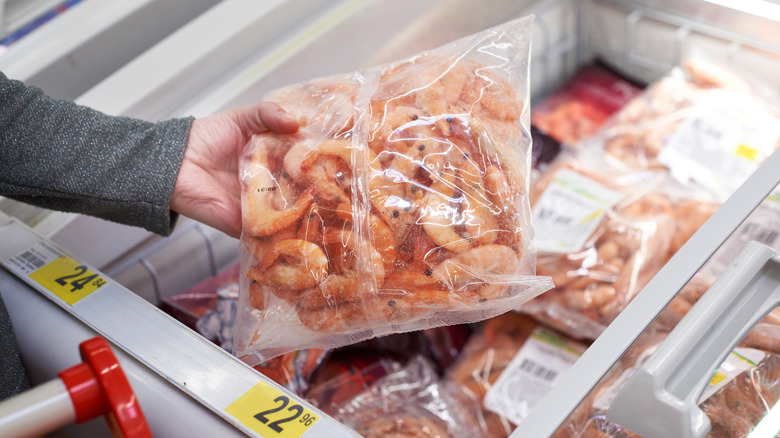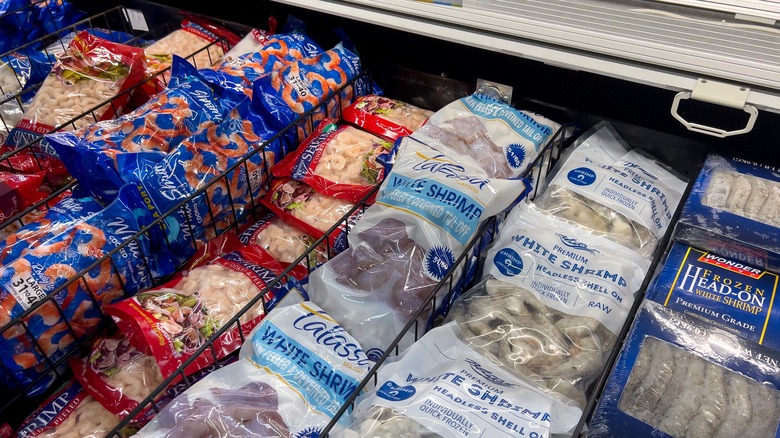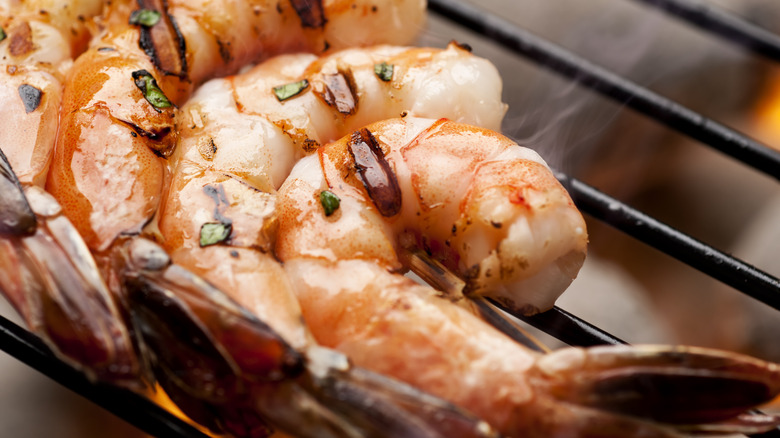How To Spot Deceptive 'Jumbo' Shrimp At The Grocery Store
Purchasing shrimp at the grocery store can get complicated, considering the many different sizes, varieties, and preparations available. The labels behind icy glass displays or on frozen bags in the cooler are typically riddled with words like "peeled," "de-veined," "tail-on," "tail-off," "raw," "cooked," "wild caught," and more. Not to mention those scary-looking, head-on shrimp typically reserved for grilling and shrimp boils.
Shrimp purchasing does not need to be intimidating; as long as you know what you are looking for, you can step up to the seafood counter with confidence. When it comes to sizing, the typical labels of small, medium, large, jumbo, and colossal are not standardized, and one brand's "medium" could be another brand's "large."
When cooking with a recipe that calls for jumbo shrimp, you are better off utilizing the number label that accompanies the shrimp. These let you know how many of that specific size of shrimp make up a pound.
What do the numbers on shrimp bags mean?
The numbers are quite easy to understand. You will typically find either the letter U (followed by a number) or two numbers (separated by a slash). Labels with U, for example U12, mean that there are 12 or fewer of those shrimp in 1 pound. Labels with a slash are distinguishing a range. For example, 12/16 means there are 12 to 16 shrimp in 1 pound.
While there is no standard for how many shrimp per pound equals small, medium, large, jumbo, or colossal shrimp, food writer Aaron Hutcherson provides a rough guide (via Washington Post): 1 pound of small shrimp usually has 51/60 shrimp, medium has 36/40 or 41/50, large has 26/30 or 31/35, jumbo has 16/20 or 21/25, and colossal has U10, U12 or U15.
You can use these numbers to make sure you are buying the right sized shrimp for your recipe — and to outsmart shrimp that has been improperly or deceptively labeled. So, if you ask for 1 pound of so-called "jumbo" shrimp and get only 15, you likely ordered improperly labeled colossal shrimp. Or if you pick up a frozen bag of "large" shrimp accompanied by the numbers 21/25, that bag actually contains larger shrimp that should be considered "jumbo."
Using different sizes and types of shrimp
Ultimately, the shrimp size that is right for you comes down to personal preference, cooking method, and recipe. Larger shrimp typically make sense for recipes that require grilling or searing, while smaller shrimp work well in stir fries or fried rice.
Size will impact how long it takes the shrimp to cook, so be cautious if using a different sized shrimp than the recipe suggests. You may end up overcooking your shrimp if you use small ones but follow cooking directions for jumbo shrimp.
Other factors to consider include the preparation of grocery store shrimp: shell-on, easy peel, or pre-peeled. In general, shell-on is recommended since it is cheaper than pre-peeled and the shells add flavor. Easy peel shrimp that are already split and de-veined can be a good alternative if you want to keep the flavor of the shell and are willing to pay a slightly higher price. As for cooked shrimp, many advise staying away entirely, since it is often overcooked and flavorless.


